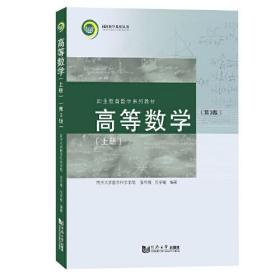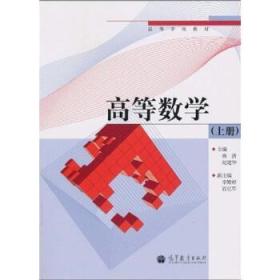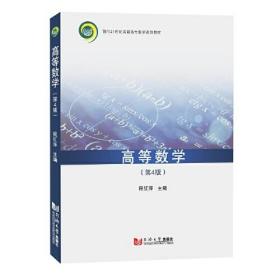
高等数学
全新正版 急速发货
¥ 24.66 5.4折 ¥ 46 全新
库存4件
江苏无锡
认证卖家担保交易快速发货售后保障
作者北京邮电大学高等数学双语教学组 编
出版社北京邮电大学出版社
ISBN9787563552726
出版时间2017-09
装帧平装
开本16开
定价46元
货号1201601248
上书时间2024-11-07
- 在售商品 暂无
- 平均发货时间 14小时
- 好评率 暂无
- 最新上架
商品详情
- 品相描述:全新
- 商品描述
-
目录
Chapter 1 Fundamental Knowledge of Calculus
1.1 Mappings and Functions
1.1.1 Sets and Their Operations
1.1.2 Mappings and Functions
1.1.3 Elementary Properties of Functions
1.1.4 Composite Functions and Inverse Functions
1.1.5 Basic Elementary Functions and Elementary Functions
Exercises 1.1 A
Exercises 1.1 B
1.2 Limits of Sequences
1.2.1 The Definition of Limit of a Sequence
1.2.2 Properties of Limits of Sequences
1.2.3 Operations of Limits of Sequences
1.2.4 Some Criteria for Existence of the Limit of a Sequence
Exercises 1.2 A
Exercises 1.2 B
1.3 The Limit of a Function
1.3.1 Concept of the Limit of a Function
1.3.2 Properties and Operations of Limits for Functions
1.3.3 Two Important Limits of Functions
Exercises 1.3 A
Exercises 1.3 B
1.4 Infinitesimal and Infinite Quantities
1.4.1 Infinitesimal Quantities
1.4.2 Infinite Quantities
1.4.3 The Order of Infinitesimals and Infinite Quantities
Exercises 1.4 A
Exercises 1.4 B
1.5 Continuous Functions
1.5.1 Continuity of Functions
1.5.2 Properties and Operations of Continuous Functions
1.5.3 Continuity of Elementary Functions
1.5.4 Discontinuous Points and Their Classification
1.5.5 Properties of Continuous Functions on a Closed Interva
Exercises 1.5 A
Exercises 1.5 B
Chapter 2 Derivative and Differentia
2.1 Concept of Derivatives
2.1.1 Introductory Examples
2.1.2 Definition of Derivatives
2.1.3 Geometric Meaning of the Derivative
2.1.4 Relationship between Derivability and Continuity
Exercises 2.1 A
Exercises 2.1 B
2.2 Rules of Finding Derivatives
2.2.1 Derivation Rules of Rational Operations
2.2.2 Derivation Rules of Composite Functions
2.2.3 Derivative of Inverse Functions
2.2.4 Derivation Formulas of Fundamental Elementary Functions
Exercises 2.2 A
Exercises 2.2 B
2.3 Higher Order Derivatives
Exercises 2.3 A
Exercises 2.3 B
2.4 Derivation of Implicit Functions and Parametric Equations,
Related Rates
2.4.1 Derivation of Implicit Functions
2.4.2 Derivation of Parametric Equations
2.4.3 Related Rates
Exercises 2.4 A
Exercises 2.4 B
2.5 Differential of the Function
2.5.1 Concept of the Differential
2.5.2 Geometric Meaning of the Differential
2.5.3 Differential Rules of Elementary Functions
2.5.4 Differential in Linear Approximate Computation
Exercises 2.5
Chapter 3 The Mean Value Theorem and Applications of Derivatives
3.1 The Mean Value Theorem
3.1.1 Rolles Theorem
3.1.2 Lagranges Theorem
3.1.3 Cauchys Theorem
Exercises 3.1 A
Exercises 3.1 B
3.2 LHospitals Rule
Exercises 3.2 A
Exercises 3.2 B
3.3 Taylors Theorem
3.3.1 Taylors Theorem
3.3.2 Applications of Taylors Theorem
Exercises 3.3 A
Exercises 3.3 B
3.4 Monotonicity, Extreme Values, Global Maxima and Minima of Functions
3.4.1 Monotonicity of Functions
3.4.2 Extreme Values
3.4.3 Global Maxima and Minima and Its Application
Exercises 3.4 A
Exercises 3.4 B
3.5 Convexity of Functions, Inflections
Exercises 3.5 A
Exercises 3.5 B
3.6 Asymptotes and Graphing Functions
Exercises 3.6
Chapter 4 Indefinite Integrals
4.1 Concepts and Properties of Indefinite Integrals
4.1.1 Antiderivatives and Indefinite Integrals
4.1.2 Formulas for Indefinite Integrals
4.1.3 Operation Rules of Indefinite Integrals
Exercises 4.1 A
Exercises 4.1 B
4.2 Integration by Substitution
4.2.1 Integration by the First Substitution
4.2.2 Integration by the Second Substitution
Exercises 4.2 A
Exercises 4.2 B
4.3 Integration by Parts
Exercises 4.3 A
Exercises 4.3 B
4.4 Integration of Rational Functions
4.4.1 Rational Functions and Partial Fractions
4.4.2 Integration of Rational Fractions
4.4.3 Antiderivatives Not Expressed by Elementary Functions
Exercises 4.4
Chapter 5 Definite Integrals
5.1 Concepts and Properties of Definite Integrals
5.1.1 Instances of Definite Integral Problems
5.1.2 The Definition of the Definite Integral
5.1.3 Properties of Definite Integrals
Exercises 5.1 A
Exercises 5.1 B
5.2 The Fundamental Theorems of Calculus
5.2.1 Fundamental Theorems of Calculus
5.2.2 Newton Leibniz Formula for Evaluation of Definite Integrals
Exercises 5.2 A
Exercises 5.2 B
5.3 Integration by Substitution and by Parts in Definite Integrals
5.3.1 Substitution in Definite Integrals
5.3.2 Integration by Parts in Definite Integrals
Exercises 5.3 A
Exercises 5.3 B
5.4 Improper Integral
5.4.1 Integration on an Infinite Interval
5.4.2 Improper Integrals with Infinite Discontinuities
Exercises 5.4 A
Exercises 5.4 B
5.5 Applications of Definite Integrals
5.5.1 Method of Setting up Elements of Integration
5.5.2 The Area of a Plane Region
5.5.3 The Arc Length of Plane Curves
5.5.4 The Volume of a Solid by Slicing and Rotation about an Axis
5.5.5 Applications of Definite Integral in Physics
Exercises 5.5 A
Exercises 5.5 B
Chapter 6 Differential Equations
6.1 Basic Concepts of Differential Equations
6.1.1 Examples of Differential Equations
6.1.2 Basic Concepts
Exercises 6.1
6.2 First Order Differential Equations
6.2.1 First Order Separable Differential Equation
6.2.2 Equations can be Reduced to Equations with Variables Separable
6.2.3 First Order Linear Equations
6.2.4 Bernoullis Equation
6.2.5 Some Examples that can be Reduced to First Order Linear Equations
Exercises 6.2
6.3 Reducible Second Order Differential Equations
Exercises 6.3
6.4 Higher Order Linear Differential Equations
6.4.1 Some Examples of Linear Differential Equation of Higher Order
6.4.2 Structure of Solutions of Linear Differential Equations
Exercises 6.4
6.5 Linear Equations with Constant Coefficients
6.5.1 Higher Order Linear Homogeneous Equations with Constant Coefficients
6.5.2 Higher Order Linear Nonhomogeneous Equations with Constant Coefficients
Exercises 6.5
6.6 *Eulers Differential Equation
Exercises 6.6
6.7 Applications of Differential Equations
Exercises 6.7
Bibliography
内容摘要
《高等数学(上 第2版 英文版)/普通高等教育“十三五”规划教材》是根据国家教育部非数学专业数学基础课教学指导分委员会制定的工科类本科数学基础课程教学基本要求编写的全英文教材,全书分为上、下两册,此为上册,主要包括函数与极限,一元函数微积分及其应用和微分方程三部分。《高等数学(上 第2版 英文版)/普通高等教育“十三五”规划教材》对基本概念的叙述清晰准确,对基本理论的论述简明易懂,例题习题的选配典型多样,强调基本运算能力的培养及理论的实际应用。《高等数学(上 第2版 英文版)/普通高等教育“十三五”规划教材》可作为高等理工科院校非数学类专业本科生的教材,也可供其他专业选用和社会读者阅读。
相关推荐
— 没有更多了 —






















以下为对购买帮助不大的评价